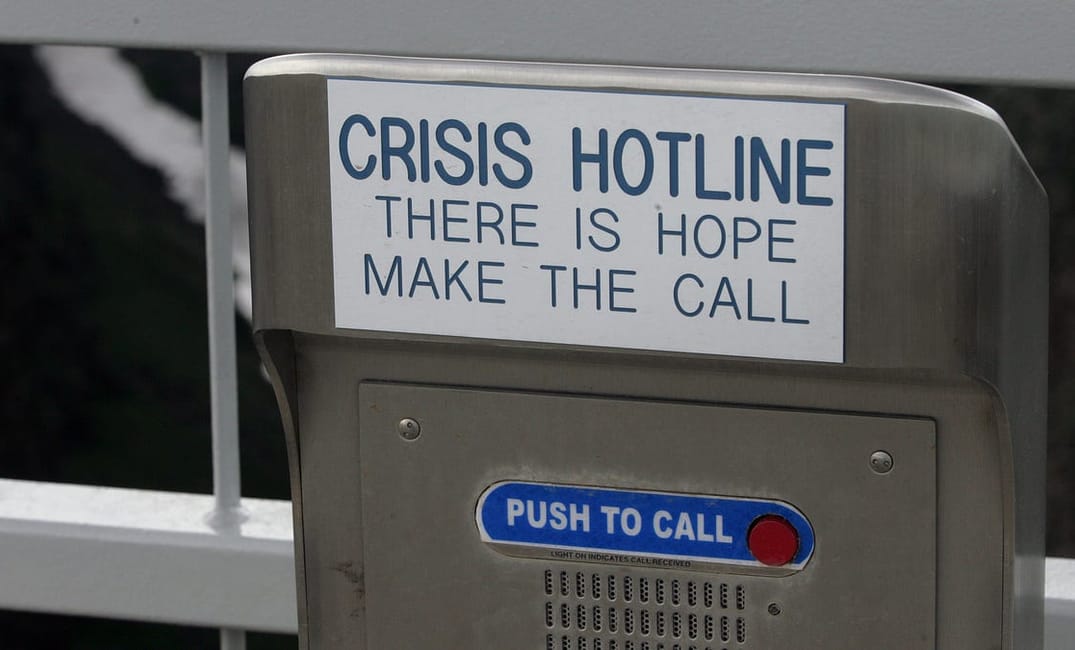
When someone calls the National Suicide Prevention Lifeline, they’re routed to one of over 180 crisis centers across the country, where health professionals and volunteers are standing by, ready to help them through a crisis.
But the first U.S. suicide hotline was a far more modest setup: a single red telephone in San Francisco’s Tenderloin District in 1961. The man behind the phone wasn’t a therapist or counselor. His name was Bernard D. Mayes, a British priest and journalist alarmed by the high suicide rate in San Francisco and compelled to do something about it.

Decades before Google and other search engines started advertising the national hotline on suicide-related search results, Mayes put cardboard advertisements on the side of city buses: “Thinking of ending it all? Call Bruce, PR1–0450, San Francisco Suicide Prevention.” The name Bruce was an alias, but the message was sincere.
Mayes received a single call on the first night after placing his ads. He took the call from his couch. By the end of that week, he had 10 callers a day. Now, 50 years on, phones on similar hotlines across the U.S. ring hundreds of times a day, many of them modeled on Mayes simple approach.
Mayes passed away in 2014, but his legacy is one that has saved and enriched countless lives. He wasn’t a trained crisis counselor, but he did possess deep empathy for others. Mayes intuitively understood that what distressed people needed was a compassionate ear and someone they felt comfortable talking to. He told the San Francisco Chronicle in 2012, “It occurred to me that we had to have some kind of service which would offer unconditional listening and that I would be this anonymous ear.”
Trained professionals play a critical role in suicide prevention, of course — but Mayes proved that anyone can provide life-changing emotional support by taking the time to listen with a nonjudgmental attitude. You don’t have to be an expert to make a difference.
Sign up for The Bold Italic newsletter to get the best of the Bay Area in your inbox every week.
Mayes had a big idea and followed his calling even though he wasn’t quite sure how he’d pull it off. He knew his calling was to provide this service for people who were struggling and had nowhere else to turn. But with no staff, no office space, and no funds, the only place he could set up his hotline was his apartment.
Unfortunately, landlords weren’t keen on the idea of a tenant who was up all hours of the night. Mayes was repeatedly turned away by landlords until he met an apartment manager in the Tenderloin district. He explained his mission of wanting to provide a listening ear for those considering suicide. To his surprise, the manager pulled back his long sleeves to reveal his own scarred wrists. The manager offered Mayes the apartment at 965 Geary Street for half price.
Beyond his suicide prevention hotline, Mayes had many other impressive accomplishments. He was a journalist, professor, author, priest, founding chairman of National Public Radio, and gay rights activist. He didn’t pigeonhole himself into a single career or trajectory — he had many identities and passions and fully embraced them all. Mayes’ life was a testament to the fact that your seemingly disparate interests all have something in common: you. Life is an opportunity to try on as many personas as you wish.
In the 50 years since Mayes founded San Francisco Suicide Prevention, suicide rates in San Francisco have declined by 50%. Mayes never took credit for this — since the hotline is anonymous, he would never say for sure whether he’d ever saved a life.

To Mayes, the focus was always that he wanted to help people, and he knew that people calling into a hotline desperately needed help. He said, “We don’t go around asking people if they are suicidal, see. They call us. … It almost worked by magic.”
Suicide is preventable. Anyone who is experiencing suicidal thoughts or a mental health crisis should immediately reach out for help by calling the National Suicide Prevention Lifeline at 1(800) 273-TALK (8255) or contact the Crisis Text Line by texting TALK to 741741. You can also reach out to the local San Francisco Crisis Line by calling (415) 781–0500 or texting MYLIFE to 741741 for 24/7 confidential support.







